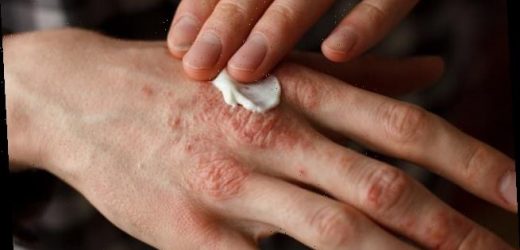Skin cell ‘atlas’ sheds light on how psoriasis and eczema develop and could lead to new treatments
- Researchers created an ‘atlas’ looking at 50,000 different skin cells
- Identified the cellular mechanisms which cause chronic skin conditions
- Found many are the same as in healthy cells and hope the database and discovery allows for future therapeutics to be developed
UK scientists have discovered how chronic skin conditions such as psoriasis and eczema develop.
Researchers from Newcastle University found cells from skin with eczema and psoriasis share many of the cellular mechanisms as developing healthy skin cells.
The team said the findings, published in the journal Science, could help in the development of new drugs targeting inflammatory skin disease.
Researchers from Newcastle University found cells from skin with eczema and psoriasis share many of the cellular mechanisms as developing healthy skin cells
Psoriasis, which affects around two per cent of people in the UK, is caused by an increased production of skin cells.
Although the process is not fully understood, the condition is thought to be related to a problem with the immune system.
Eczema, which causes the skin to become itchy, dry and cracked, is more common in children but can improve as they get older.
There are no cures for the conditions and treatments can only relieve the symptoms.
Scientists created a detailed map of the human skin as part of the global Human Cell Atlas effort to map every cell type in the human body.
They looked at how cells develop in healthy skin as well as as skin from eczema and psoriasis patients.
People with sensitive skin may be at risk of eczema flare-ups triggered by wearing a face mask.
Medics reveal a 60-year-old man with a history of several skin allergies suffered a bout of dermatitis brought on by his mask.
After initially struggling to diagnose the root of the issue, doctors realised it was the elastic bands of his face mask which was the cause.
The patient was diagnosed with a case of contact dermatitis, a form of eczema fuelled by a reaction to a substance or material.
The American man was put on medication with prednisone, a regular anti-allergy drug, before the mask issue was spotted.
But this was ineffective and the man later returned to his doctors with the issue.
After identifying the location on the face was in the same place as a mask sits, the doctors speculated the form of PPE may be to blame.
Analysis of more than 500,000 skin cells revealed that diseased cells shared many of the same molecular pathways as developing cells.
Professor Muzlifah Haniffa, co-senior author from Newcastle University and Associate Faculty at the Wellcome Sanger Institute, said: ‘This Skin Cell Atlas reveals specific molecular signals sent by healthy developing skin to summon immune cells and form a protective layer.
‘We were amazed to see that eczema and psoriasis skin cells were sending the same molecular signals, which could over activate immune cells and cause the disease.
‘This had never been seen before. Discovering that developing cell pathways re-emerge is a huge leap in our understanding of inflammatory skin disease, and offers new routes for finding treatments.’
The researchers said their study also opens up new avenues for research on other inflammatory diseases such as rheumatoid arthritis and inflammatory bowel disease and could have ‘great implications’ for regenerative medicine, especially for burns victims.
Professor Fiona Watt, co-senior author from Kings College London, said: ‘There have been decades of research on skin cells grown in the laboratory.
‘However, it is not always clear how the properties of the cells change in the laboratory setting.
‘By revealing the detailed make-up of cells immediately on isolation from developing and adult human skin, this Skin Cell Atlas can act as a template for researchers trying to reconstruct healthy skin in regenerative medicine.’
Source: Read Full Article



